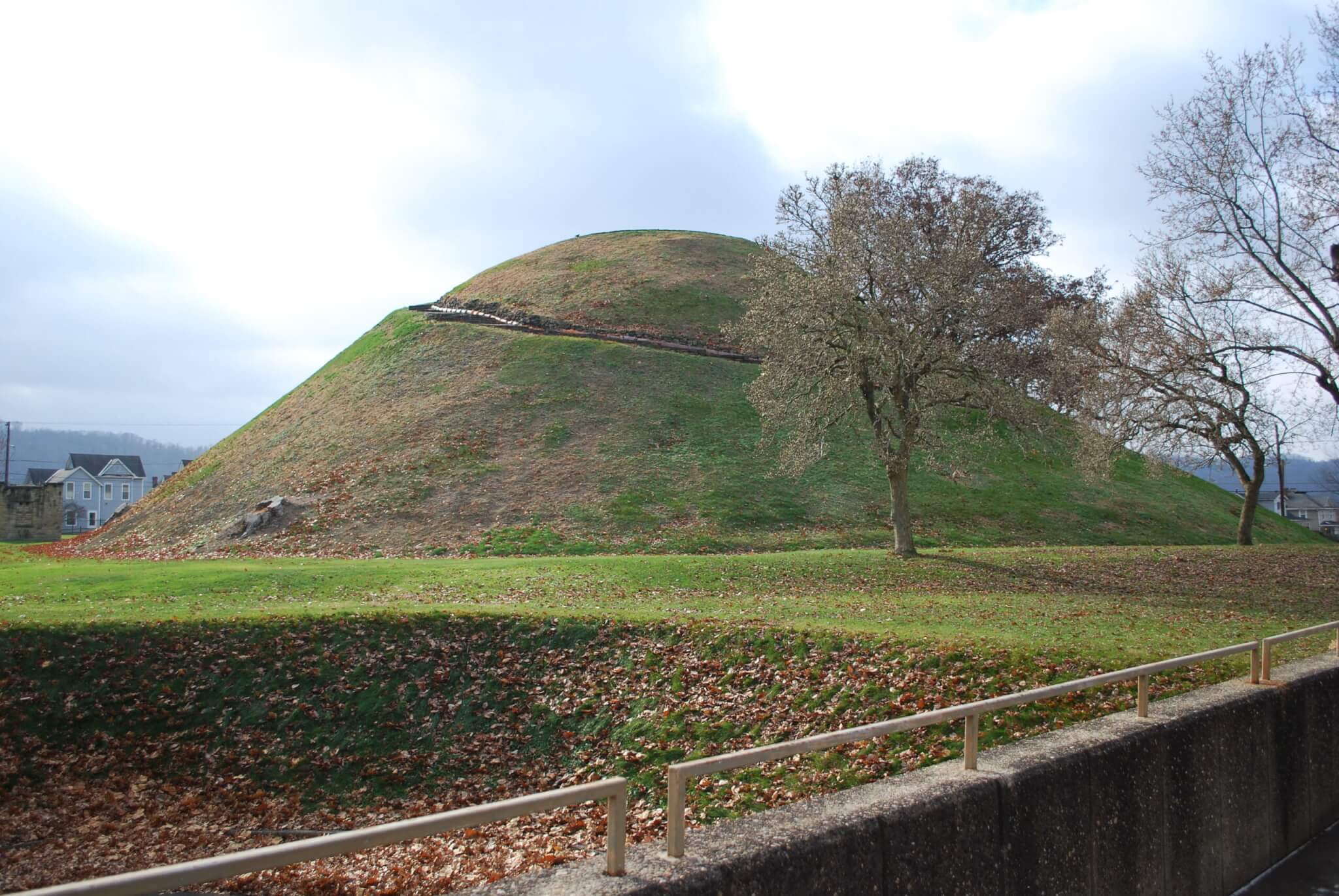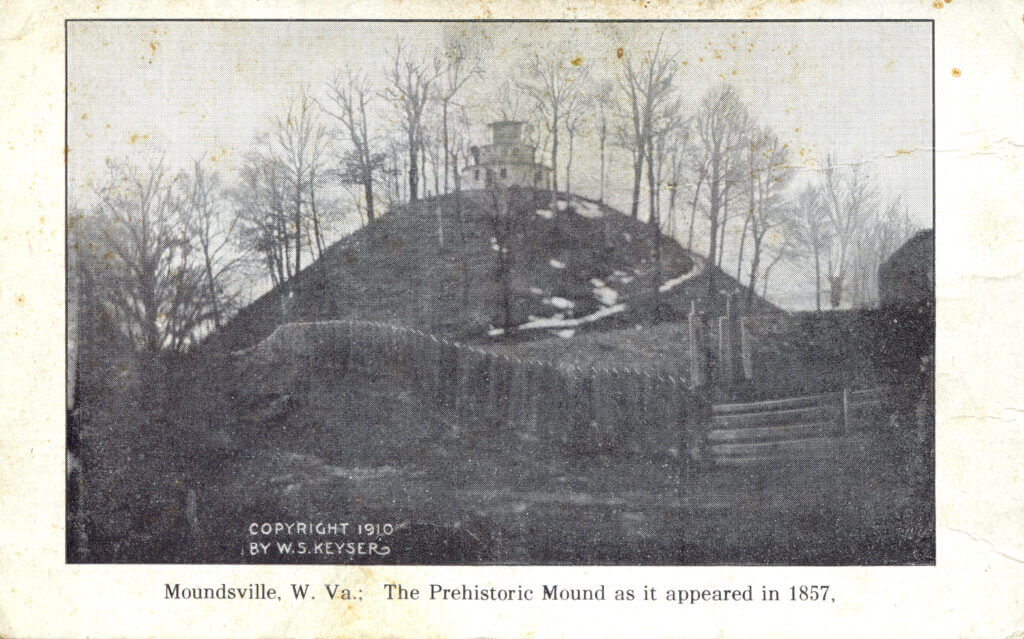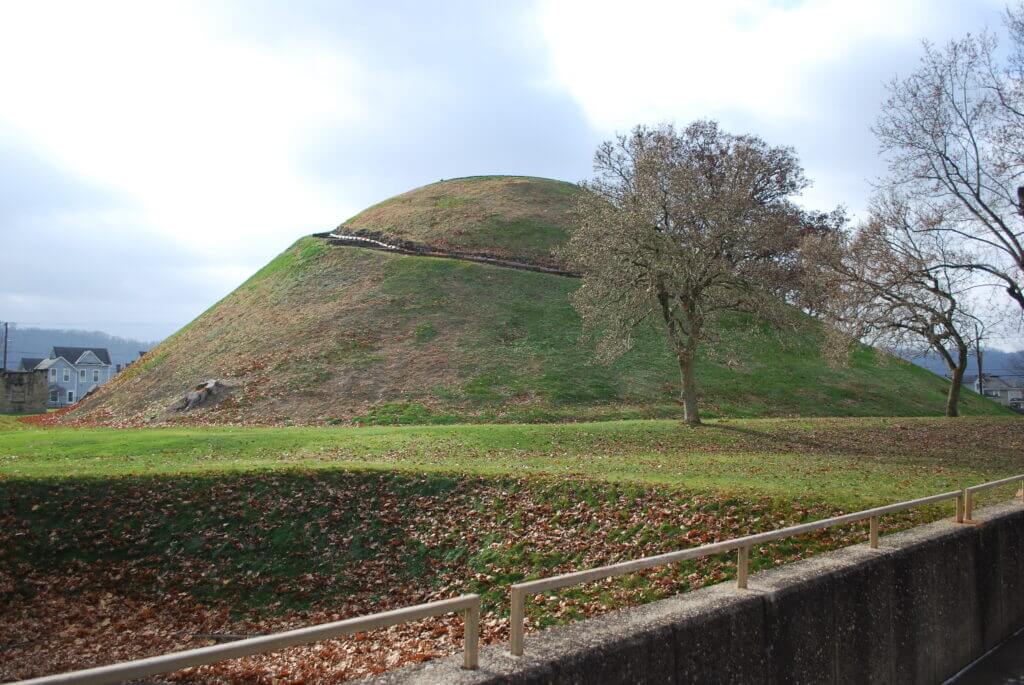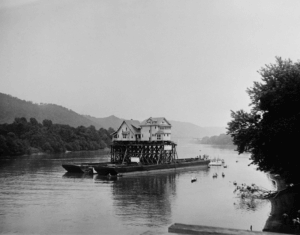
Unearthing the real story behind West Virginia’s most famous archaeological fraud.
This story was originally published in the March 2019 issue of Wonderful West Virginia, and was updated in March 2023 by Wonderful West Virginia staff. To subscribe, visit wonderfulwv.com.
Written by Zack Harold
In early February 1839, subscribers of the Cincinnati Chronicle opened their newspapers to find a 4,000-word article about some strange happenings in Moundsville, Virginia.
Two archaeologists were in the process of excavating a large mound at the “flats of Grave Creek.” The author of the article, Thomas Townsend, predicted their findings would bring worldwide fame to the tiny panhandle town, making it “a place desirable to be visited by foreigners, by the curious and by the antiquary from all parts of the world.”
It was a bold claim, given how few artifacts were found inside the mound. The archaeologists discovered three poorly preserved skeletons, some seashells, decorative stones, beads, and a few copper bracelets. Impressive, sure, but other excavated mounds had surrendered similar treasures in much greater quantities.
It was a single discovery that set the Grave Creek Mound apart from all the others. Diggers had come across a “small thin flat stone of common fine grey sand stone” with “some hieroglyphics engraved upon it,” Townsend wrote.
The Chronicle included a drawing of the stone alongside Townsend’s article. The 23 symbols did not appear to come from any known language, but 22 of them were arranged in three neat horizontal rows. The 23rd symbol stretched across the bottom of the stone, almost like the signature at the end of a letter.

courtesy of Wheeling College Collection
To Townsend, the engraved stone and the copper bracelets signified “considerable advancement” in whatever ancient society was responsible for the mound. This raised many questions. When was the mound built? Who built it? Where did those people come from? And what was the Grave Creek Stone, as it became known, trying to tell us?
We now have answers to each of these questions, although they probably aren’t the kind of answers Townsend and his readers expected. This is especially true when it comes to the Grave Creek Stone. Thanks to years of research, we now know exactly what the tablet is: a great big fraud.
The Mound Takes Shape
The Grave Creek Mound began as a naturally occuring hill, formed eons before humans arrived in Appalachia. When the Adena people moved into the region around 10,000 B.C. and discovered the landform, they decided it would be a good place to bury important members of their community.
To bury their dead, the Adena dug a rectangular trench in the hill, lined the sides of the hole with logs, and covered the top with wooden beams, on which they laid stone slabs. Somewhere around 250 to 150 B.C., they started adding soil to the hill. By the time they were finished, they had dumped an estimated 60,000 tons of earth on top. If we estimate each load of soil weighed about 30 pounds, that means the Adena added about 3 million basket loads of dirt to the mound.
They also dug a moat around the mound. The sandy soil would not have allowed the trench to fill with water, so the moat likely served as a symbolic barrier—maybe a dividing line between the sacred and the profane. “But that’s just an interpretation. We really have no way of knowing,” says Andrea Keller, programming coordinator at the Grave Creek Mound Archaeological Complex.

courtesy of West Virginia State Archives
Tribes built similar burial mounds throughout the Ohio Valley and then disappeared, leaving the mounds behind. By the time Europeans arrived in the New World, they were captivated by these gargantuan earthworks. They understood the mounds were man-made, judging by their size and locations, but had no idea who built them. Theories arose, claiming the mounds were built by lost societies of European or Middle Eastern people who came to North America long before Christopher Columbus.
Tribes built similar burial mounds throughout the Ohio Valley. Then they disappeared, leaving the mounds behind. When Europeans arrived in the New World, they were instantly captivated by these gargantuan earthworks. They understood the mounds were man-made but, because they had no idea who built them, they came up with theories that the mounds were built by lost societies of European or Middle Eastern people who came to North America long before Christopher Columbus.
These theories were largely based in racial prejudice. It would have been logical—and correct—to assume Native Americans built the mounds, since both Native Americans and mounds were present long before Europeans arrived. But that origin story didn’t jibe with the white settlers’ view of the “savages” who inhabited North America. “They thought it spoke to a level of civilization that the American Indians didn’t meet,” says Brad Lepper, curator of archaeology at the Ohio History Connection in Columbus, Ohio.
So if the Native Americans didn’t build the mounds, the settlers wondered, who did?
Digging In
Eventually people started excavating burial mounds to see what answers they might hold. Thomas Jefferson even dug up a burial mound at Monticello in 1784, just a year after the Treaty of Paris ended the Revolutionary War.
The excavations at Grave Creek began in March 1838. The efforts were led by Abelard Tomlinson, whose grandfather discovered the mound while hunting and whose family now owned the land, and his brother-in-law Thomas Biggs. They started their work low on the mound, unearthing a tomb that contained a pair of skeletons arranged so their heads were almost touching and the feet were pointing in opposite directions.
The bones were too deteriorated to determine the gender of the dead, but each had a perfect set of teeth. Judging by the wear on these teeth, the researchers guessed the people had been about 60 years old when they died. One of the skeletons was adorned with hundreds of beads made from either shell or ivory, as well as a “rude ornament of stone,” according to Townsend. Tomlinson and Biggs surmised the decorated skeleton belonged to a chief and the unadorned remains were his wife.
A few months later, Tomlinson and Biggs began digging out a second burial chamber a little higher on the mound. Here they found a single skeleton—also with perfect teeth—along with five copper bracelets, 1,700 ivory beads, 500 seashells, and 66 pieces of mica.

photographed by Rhonda Humphreys
This is also where the diggers found the Grave Creek Stone. Accounts of its discovery differ. Tomlinson said he found the stone inside the upper burial chamber, but workers said they found it in a wheelbarrow as they hauled away a load of earth.
Either way, it seems the excavation crew didn’t give the stone much thought. Controversy about its origins did not begin until some months later, when noted 19th century ethnologist and Native American expert Henry Rowe Schoolcraft studied the stone and decided it had been carved by ancient Celts from Britain or Spain. This invited theories from other scholars, who attributed the writing to the Egyptians, Greeks, Phoenicians, and Tunisians, among others.
Still other scholars did not view the Grave Creek Stone as a relic of an ancient lost civilization. They smelled a fraud. Chief in this camp was archaeologist Ephraim George Squier. He viewed the stone as suspect because a published version of the excavation’s daily log failed to mention its discovery.
As years passed, more and more archaeologists began to cast doubt on the Grave Creek Stone’s authenticity. For one thing, there is no proof of pre-Columbian immigration to the modern day United States. “We’ve got ancient DNA from Native American skeletons that date back 10,000 years. And as far back as we go, there’s no element of Africans or Europeans,” Ohio History Connection’s Lepper says. “The genetics, the archaeology, everything is consistent with the story that we have developed.”
But one important question remained unanswered: If the stone was fake, who made it?
“An Open and Shut Case”
In the early 2000s, New York anthropologist David Oestreicher decided to take on the case of the Grave Creek Stone. He had made a career studying the Lenape Indians, who originally hailed from New England before being forced onto reservations in Oklahoma. This research led him to the Walam Olum, a collection of Lenape creation and migration myths that caused some controversy when they were published in the 1830s.

courtesy of Smithsonian Institution
A noted ethnologist from the time—none other than Henry Rowe Schoolcraft—believed the literature was fake, while his rival, the archaeologist Ephraim George Squier, believed it was legitimate. Oestreicher spent years researching the controversy and was eventually able to prove the Lenape myths were, as Schoolcraft suspected, a contemporary fabrication.
When Oestreicher learned that Schoolcraft and Squier later found themselves on opposite sides of the Grave Creek Stone controversy as well, he couldn’t resist digging into the story himself. He uncovered lots of manuscripts that had never seen the light of day. This included the original, unedited manuscript of the record book that had caused Squier to doubt the stone’s authenticity.
Oestreicher discovered the logbook had been penned by Dr. James W. Clemens, a prominent Wheeling physician, city councilman, poet, and, apparently, archaeology booster. He also noticed that Clemens’ original manuscript did in fact contain an account of the Grave Creek Stone’s discovery. And Clemens didn’t just mention the stone—he expounded on its potential significance. For some reason, this passage had been edited out of the final published text.
Instead of giving him faith in the stone’s authenticity, the manuscript made Oestreicher suspicious of Clemens. He dug into the doctor’s life and learned that Clemens had had a lot riding on this excavation. Convinced the mound would contain a king’s store of treasures, Clemens had borrowed about $2,600—more than $60,000 in today’s money—to fund the venture. Clemens had also tried to get others to buy into the project. Oestreicher discovered an 1838 Marshall County Sentinel article the doctor wrote in an attempt to solicit investment in the excavation. He’d told readers the mound would yield heaps of treasure, become a global tourist attraction, and induce the growing Baltimore and Ohio Railroad to route its railway through Wheeling.
All this gave Oestreicher a hunch that Clemens fabricated the Grave Creek Stone in an effort to save the lackluster excavation project. But what about the characters on the stone? Surely random scribblings would not fool experienced archaeologists, ethnographers, and linguists.
Oestreicher found his answer in a 1752 volume titled An Essay on the Alphabets of the Unknown Letters That are Found in the Most Ancient Coins and Monuments of Spain, written by Spanish historian Don Luis Jose Velazquez. “Everything on the stone can be accounted for in Velazquez’s book,” Oestreicher told Rick Steelhammer of the Charleston Gazette in 2008. “Identical clusters of letters from the book show up on the Grave Creek Stone, sometimes in the same order.” Even some of Velazquez’s errors show up on the stone.
It isn’t a stretch to imagine Clemens would have access to Velazquez’s book. He was a known bibliophile with more than 600 volumes in his personal library—not a small collection today, but especially impressive in a time when books were very expensive. Clemens even had a machine shop where he could have easily engraved the stone.

photographed by Jeremy Kohus
Just like a good prosecuting attorney, Oestreicher proved Clemens had the means, motive, and opportunity to commit the fraud. His case was so strong that most academics now agree that Clemens was the culprit. Even the exhibits at the Grave Creek Mound Archaeological Complex, which originally focused on attempts to translate the stone, were recently updated to reflect Oestreicher’s findings.
“After Oestreicher, it’s an open and shut case,” Lepper says.
Enduring Mysteries, Lasting Legacy
Although researchers have answered many questions about the Grave Creek Mound, mysteries still surround the landmark.
First and foremost, no one knows the whereabouts of any of the artifacts pulled from the Grave Creek Mound, including the Grave Creek Stone. About a year after the excavation was completed, Tomlinson and company opened a small museum inside the mound to display the artifacts they had unearthed. The tourism boom that Townsend predicted in the Cincinnati Chronicle never happened, though. The museum was bankrupt within two years and the owners sold off its collection.
Documentation of the sale has been lost to history. Some have suggested the collection went to the Blackmore Museum in England, which was later absorbed by the British Museum, “It’s possible the Grave Creek Stone is in England somewhere. But that’s just one thread,” says Keller at the Grave Creek Mound Archaeological Complex. Other accounts place the stone in Tennessee, or in the bowels of a library somewhere in West Virginia. It is certain that the stone passed through the Smithsonian Institution at some point, because the museum has photographs and four wax casts of the stone in its collection.
We also do not know if the mound contains any additional burials. “It’s not out of the realm of possibility,” Keller says. During the original excavation at Grave Creek, one of the archaeologists identified a few more potential burial chambers, although they were never investigated. A graduate student recently studied the mound using remote sensors and discovered “anomalies” in the mound. “At this point, we don’t know what they are. They could be anything from a tree root to a rodent burrow to a little excavation—or it could be something prehistoric,” Keller says.
If treasures remain in the mound, we will likely never see them. Since there’s no pressing reason to disturb these sacred grounds, it’s unlikely another excavation will ever take place. “Once you dig it up, you can’t put it back,” Keller says.
Besides, there’s plenty to appreciate about the mound without removing one shovel of soil. Whether you’re standing at the top looking over the gothic stone walls of the West Virginia State Penitentiary, located just across the street, or standing at the base of the mound looking up at the tons of earth that human hands and feet moved to this spot, the people who built this colossal tomb don’t seem 2,000 years away.
“It’s very elaborate, when you think about it. It’s a monument,” Keller says. “I’m sure it wasn’t any more fun to carry dirt around than it is now. They were really making a sacrifice.”














